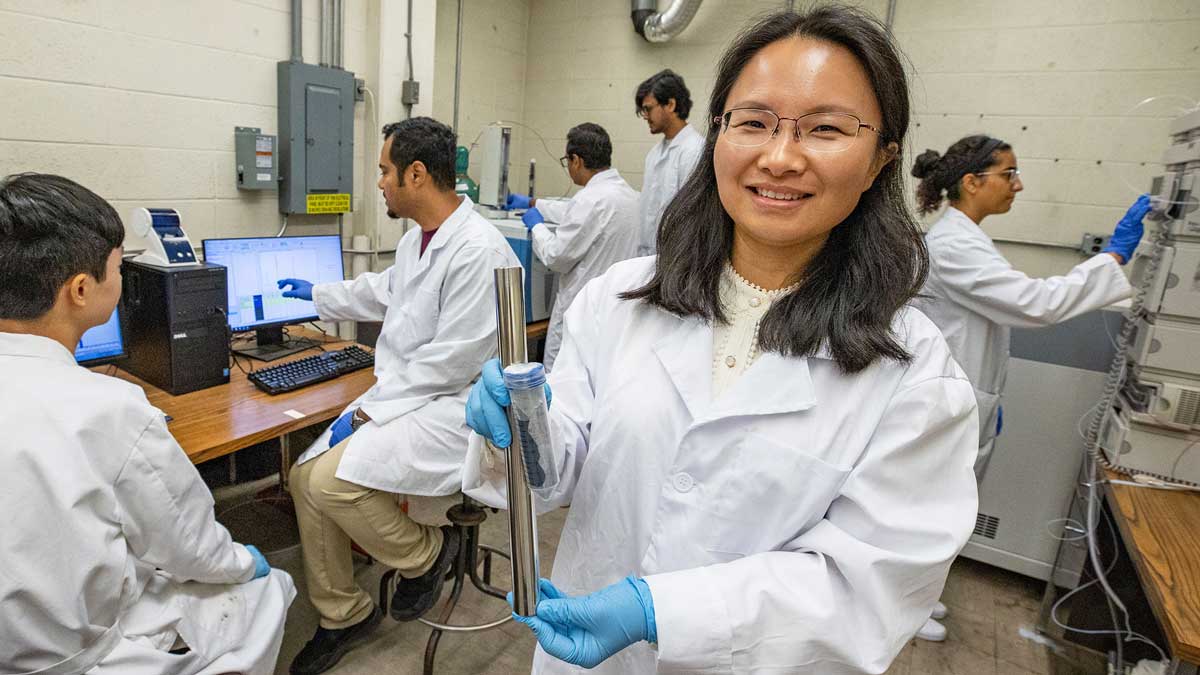
Jia Liu, foreground, associate professor of civil and environmental engineering, works with students in her lab at SIU. Liu is working with a three-year grant of nearly $500,000 from the National Science Foundation to investigate using magnetic nanomaterials to treat groundwater contaminated with per- and polyfluoroalkyl substances, or PFAS. (Photo by Russell Bailey)
September 10, 2024
$500K SIU study focuses on removing ‘forever chemicals’ from water
CARBONDALE, Ill. – Life itself springs from the ground in the form of water, and a researcher at Southern Illinois University Carbondale is seeking to eliminate PFAS, also known as “forever chemicals,” from this life-giving substance by using nanoparticles and light.
Jia Liu, associate professor of civil and environmental engineering, is working with a three-year grant of nearly $500,000 from the National Science Foundation to investigate using magnetic nanomaterials to treat groundwater contaminated with per- and polyfluoroalkyl substances, or PFAS. Liu and her team are exploring the challenges of constructing a pilot-scale treatment unit based on the developing technology and builds on Liu’s previous grant-funded work in this area.
An emerging concern
PFAS are commonly used in many products and processes and have made life easier in many ways. They are a key ingredient in such things as firefighting substances to food packaging and Teflon products. They can make fabrics both breathable and waterproof.
With such ubiquitous use, PFAS are commonly found throughout the environment, including in surface water, sediments, air, soil and sludge. But scientists also have noted these substances stick around in the environment long after being used. This, among other factors, gives PFASs the potential to build up in the bodies of living organisms, where they might potentially cause adverse effects.
The EPA of late has taken special note of the issue, issuing national primary drinking water
regulations for certain PFAS and announcing health advisories for others when higher levels are detected and continuing to study the issue.
A track record of success
Beginning in 2018, Liu began receiving grants from the U.S. EPA’s People, Prosperity and the Planet program to study ways of eliminating PFAS from the environment. Those efforts were focused on effluents released from wastewater treatment plants, which do not remove PFAS.
That research team, which also included faculty members Boyd Goodson, Michael Lydy and Jane Geisler-Lee, as well as SIU students, successfully used iron nanomaterials under ultraviolet light to remove PFAS from the water and demonstrated an innovative point-of-use system that could potentially be deployed at scale in the real world.
“Building on this work, our current NSF-funded project seeks to explore a more efficient treatment method for PFAS in contaminated groundwater,” Liu said.
While the focus will remain on removing PFAS, the researchers also will wrestle with removing additional contaminants, such as chlorinated solvents from industrial activities or landfills, that often are mixed in with PFAS. Both PFAS and chlorinated solvents pose significant health risks, and their persistence in the environment makes them particularly challenging to remediate.
“The coexistence of these contaminants further complicates our remediation efforts, and it is driving growing interest in finding effective treatment methods that can address both,” Liu said.
“Our focus will be on pilot-scale remediation of PFAS at contaminated sites, with an additional investigation into how the presence of these cocontaminants affects the removal process.”
Taking it to the next level
As pioneered with the previous EPA grants, Liu and her team will again use a process known as photocatalysis. Photocatalysis uses light to accelerate a chemical reaction. The process uses iron nanoparticles inside a photoreactor to remove PFAS from water samples.
Photocatalysis represents an elegant, low-cost approach to the problem, but in this case, the researchers will pair it with another approach known as dark-light adsorption. In this new, two-phased process, the contaminated groundwater will first enter the reactor containing an iron-carbon nanohybrid material under dark conditions.
As the contaminated water first flows into the reactor in a dark environment, PFAS contaminants are expected to adsorb onto the surface of the material, concentrating them. After this adsorption phase, ultraviolet light will be turned on, and the water flow will be stopped to create a batch reactor.
The two-phased approach will make it easier to treat large volumes of water, Liu said.
“This approach allows us to first concentrate PFAS under dark conditions and then degrade them under light exposure,” Liu said. “This dark-light alternating process within the same reactor, using the same nanomaterials, is expected to not only remove PFAS contaminants from the water but also degrade them effectively.”
Hope for the future
The project, which began in September 2023, is scheduled to end in 2026. If all goes well, the team of Liu, along with at least two doctoral students, one graduate student and two undergraduates, will successfully build a working, pilot-scale reactor of a “bench-top” size holding about 12 gallons. That reactor would then be integrated with other pre- and post-treatment reactors to enhance groundwater treatment for field operations.
“If we’re successful, we’ll advance the development and deployment of efficient and sustainable technologies for the treatment and remediation of groundwater aquifers contaminated by mixtures of PFAS and chlorinated solvents,” Liu said.
Note: Jia Liu is pronounced “JEE-ah LEE-uu”
